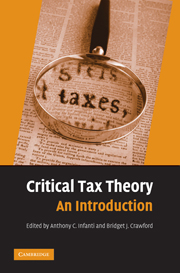Book contents
- Frontmatter
- Contents
- List of Illustrations
- List of Tables
- List of Contributors
- List of Common Abbreviations
- Introduction
- CHAPTER 1 FOUNDATIONS OF CRITICAL TAX THEORY
- CHAPTER 2 HISTORICAL PERSPECTIVES ON TAXATION
- CHAPTER 3 THE GOALS OF TAX POLICY
- Racial Equality in the Twenty-First Century: What's Tax Policy Got to Do with It?
- Discursive Deficits: A Feminist Perspective on the Power of Technical Knowledge in Fiscal Law and Policy
- The Hidden Costs of the Progressivity Debate
- Tax Equity
- Tax Policy and Feminism: Competing Goals and Institutional Choices
- CHAPTER 4 CRITICAL TAX THEORY MEETS PRACTICE
- CHAPTER 5 RACE AND TAXATION
- CHAPTER 6 GENDER AND TAXATION
- CHAPTER 7 SEXUAL ORIENTATION AND TAXATION
- CHAPTER 8 THE FAMILY AND TAXATION
- CHAPTER 9 CLASS AND TAXATION
- CHAPTER 10 DISABILITY AND TAXATION
- CHAPTER 11 GLOBAL CRITICAL PERSPECTIVES ON TAXATION
- CHAPTER 12 CRITICAL PERSPECTIVES ON CRITICAL TAX THEORY
- Index
Tax Equity
Published online by Cambridge University Press: 04 August 2010
- Frontmatter
- Contents
- List of Illustrations
- List of Tables
- List of Contributors
- List of Common Abbreviations
- Introduction
- CHAPTER 1 FOUNDATIONS OF CRITICAL TAX THEORY
- CHAPTER 2 HISTORICAL PERSPECTIVES ON TAXATION
- CHAPTER 3 THE GOALS OF TAX POLICY
- Racial Equality in the Twenty-First Century: What's Tax Policy Got to Do with It?
- Discursive Deficits: A Feminist Perspective on the Power of Technical Knowledge in Fiscal Law and Policy
- The Hidden Costs of the Progressivity Debate
- Tax Equity
- Tax Policy and Feminism: Competing Goals and Institutional Choices
- CHAPTER 4 CRITICAL TAX THEORY MEETS PRACTICE
- CHAPTER 5 RACE AND TAXATION
- CHAPTER 6 GENDER AND TAXATION
- CHAPTER 7 SEXUAL ORIENTATION AND TAXATION
- CHAPTER 8 THE FAMILY AND TAXATION
- CHAPTER 9 CLASS AND TAXATION
- CHAPTER 10 DISABILITY AND TAXATION
- CHAPTER 11 GLOBAL CRITICAL PERSPECTIVES ON TAXATION
- CHAPTER 12 CRITICAL PERSPECTIVES ON CRITICAL TAX THEORY
- Index
Summary
Each year when I teach federal income tax, one of the topics that I reflexively cover with my students in the first or second class is the triad of tax policy concerns – efficiency, equity, and administrability – that will inform many of our discussions during the semester. Whether the topic is an objective test for deducting the cost of work-related clothing or the propriety of taxing capital gains at preferential rates, I have found that introducing students to the notion that we should strive for a tax system that (1) minimizes interference with economic decision making, (2) is fair, and (3) is easy to administer and comply with, helps them to see tax not as a dry and arcane subject, but as one that involves the balancing of important policy considerations that have a real, everyday impact on all of our lives. Evidence that others share in the belief that it is important to introduce these tax policy concerns to students early on in their tax education can be found in the large number of basic income tax textbooks that begin with a discussion of them.
Tax equity, the topic of this article, has influenced not only classroom debate, but also political debates and, to a lesser extent, judicial application of the tax laws. In academic circles, however, tax equity has engendered significant controversy. For decades, commentators have debated the choice of progressivity (as opposed to proportionality or regressivity) as the most appropriate means of achieving ”vertical” equity in the income tax (i.e., of differentiating the tax burdens imposed on taxpayers with unequal incomes).
- Type
- Chapter
- Information
- Critical Tax TheoryAn Introduction, pp. 60 - 64Publisher: Cambridge University PressPrint publication year: 2009



